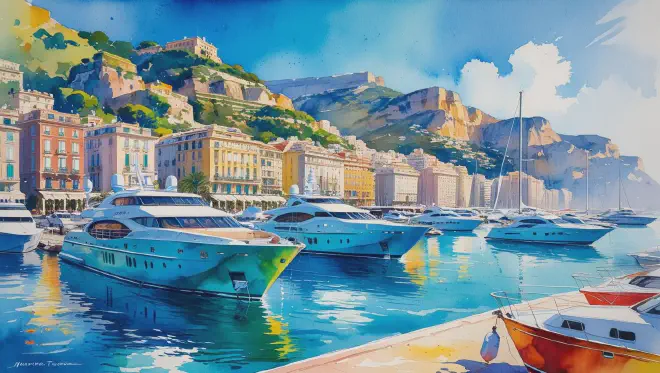Introduction
Monaco, the jewel of the Mediterranean. This second-smallest sovereign state in the world, nestled between France and Italy, compresses luxury and elegance into a mere two square kilometers. The Principality, ruled by the House of Grimaldi for over 700 years, is renowned for the glamorous casinos of Monte Carlo, the street corners where Formula 1 Monaco Grand Prix races through, and white buildings reflected against the azure Mediterranean Sea.
From the old town of Monaco-Ville built atop rocky cliffs to the harbor town of La Condamine and the modern Monte Carlo, different neighborhoods with distinct characters dot this small territory. Blessed with the mild climate of the Provence region, flowers bloom year-round, with roses and bougainvillea particularly adorning the street corners.
Visitors to this nation are enchanted by the unique atmosphere where royal history harmonizes with modern sophistication. While French serves as the official language, the indigenous Monégasque language also survives, keeping diverse cultures alive. Despite the brief three-day, two-night stay, I hoped this journey would reveal the depth of charm this small principality possesses as I departed from Narita Airport via Paris to Nice Côte d’Azur Airport.

Day 1: Arrival at the Mediterranean Jewel
Landing at Nice Airport in the morning, I took a bus toward Monaco. The route tracing the Côte d’Azur coastline was picture-postcard beautiful. The deep blue Mediterranean stretched to my right while limestone cliffs continued on the left. After about 45 minutes, crossing into Monaco’s border, the very air seemed to change.
Walking from Monaco-Ville station to my hotel, the Monaco streetscape I first encountered was more compact and beautiful than I had imagined. Buildings featured white and beige tones with red tile roofs harmonizing magnificently with the Mediterranean blue. Palm trees lining the streets created a tropical atmosphere, while the stone-paved roads carried the weight of history.
After checking in, I ventured into the streets for a meal. The warm afternoon sun illuminated café terraces where locals leisurely passed their time—a striking scene. At a small bistro, I ordered a Niçoise salad and pan bagnat. The salad, beautifully arranged with tomatoes, anchovies, olives, and hard-boiled eggs, seemed to concentrate Mediterranean bounty onto a single plate. Pan bagnat, a regional dish of round bread filled with tomatoes, anchovies, and olive oil, was simple yet highlighted the ingredients’ natural flavors.
In the afternoon, I visited Monaco Cathedral. Formally known as Saint Nicholas Cathedral, this church was a beautiful Romanesque-Byzantine structure built in the late 19th century. The white stone exterior gleamed in the intense Mediterranean sun, while stained glass windows inside created a mystical atmosphere with their multicolored light. Here rests Grace Kelly, the film actress who became Princess of Monaco. As I paid my respects at her grave, an elderly woman approached and said in English, “She truly was a beautiful woman.” Though our conversation was brief, I could feel the deep affection Monaco’s people held for Princess Grace.
In the evening, I strolled through the old town of Monaco-Ville. The view from Palace Square was breathtakingly beautiful, overlooking Monaco Harbor below and extending to the French coastline in the distance. Though I missed the changing of the guard ceremony, simply standing before the palace allowed me to sense the dignity of the House of Grimaldi’s 700-year history.
For dinner, I dined in the harbor town of La Condamine. The bouillabaisse I ordered at a small restaurant was a masterpiece of regional cuisine, abundant with Mediterranean seafood. The saffron aroma stimulated my appetite, and the fish-based broth warmed me to my core. I chose a white Côtes de Provence wine—its subtle saltiness and citrus freshness paired wonderfully with the dish, orchestrating the Mediterranean evening.
Through the restaurant window, I could see Monaco Harbor illuminated in the night scenery. White yachts lined up in orderly fashion exuded an elegance different from daytime. As I enjoyed my meal while contemplating tomorrow’s plans, anticipation naturally swelled within me.
Day 2: Touching Royal History and Ocean Mysteries
Morning began with croissants and café au lait at the hotel breakfast. From the balcony, I could see the Mediterranean’s gentle waves, the morning sea as still as a mirror. After breakfast, I decided to first tour the palace.
The morning palace visit allowed me to touch upon the long history of the House of Grimaldi. Each room with its lavish interior displayed portraits of successive princes and princesses, with particularly numerous photographs of Princess Grace. Following the Japanese audio guide, I toured the Throne Room, Hall of Mirrors, and Blue Room in sequence. The Blue Room’s wallpaper, imported from 18th-century France, still maintained its vivid blue color.
From the palace gardens, I could gaze upon spectacular Mediterranean views. En route to the Exotic Garden, cacti and aloe plants created a tropical atmosphere. The warmth of the Mediterranean climate likely kept these plants green and thriving year-round.
In the afternoon, I visited the world-famous Oceanographic Museum. This museum, established in 1910 by Prince Albert I, who was also an oceanographer, is a white building perched on a cliff face, truly worthy of being called Monaco’s landmark.
The museum’s aquarium, centered on Mediterranean marine life, featured a particularly spectacular shark tank. Walking through the transparent tunnel while looking up at sharks swimming overhead created the sensation of being underwater. The tropical fish tanks were vibrantly colorful, echoing with children’s delighted voices. Japanese tourist families were also present, and seeing children excitedly pointing at fish, I felt a shared wonder that transcended borders.
On the museum’s upper floors, I explored exhibits on oceanographic history and deep-sea exploration. Prince Albert I’s deep-sea exploration equipment and specimens of collected deep-sea creatures conveyed his passion for marine research.
In the late afternoon, I strolled through the Monte Carlo district. Before the Casino de Monte-Carlo, luxury cars arrived one after another, with elegantly dressed people coming and going. Though I didn’t enter, the building’s beauty alone provided ample visual pleasure. The Belle Époque architecture carries the glamour of the late 19th century into the present.
In the evening, I walked around the Opera House area. The Monte Carlo Opera House, designed by Charles Garnier who also designed the Paris Opera, is worth seeing for its magnificently ornate exterior. Though no performance was scheduled, simply standing before the building allowed me to imagine the glittering nighttime world once staged here.
For dinner, I dined at a Michelin-starred restaurant. The dishes using fresh Mediterranean fish were simple yet refined. The seafood carpaccio appetizer, dressed with lemon and olive oil, highlighted the fish’s freshness. The main course of grilled sea bream, flavored with Provençal herbs and accompanied by ratatouille, delivered the taste of southern French sunshine.
The Chassagne-Montrachet white wine selected by the sommelier paired perfectly with the meal. Its subtle oak notes and rich fruit flavors enhanced the delicate taste of the fish dishes.
After dinner, I took a leisurely walk while admiring Monaco Harbor’s night scenery. Yacht lights reflected on the water surface created jewel-like beauty. Casino sounds drifted from the distance, but the harbor area remained quiet, with pleasant Mediterranean night breezes.
Day 3: Morning of Farewell and Eternal Memories
On the final morning, I rose early to visit the Exotic Garden. In the morning stillness, various cacti and succulents gleamed beautifully in the sunlight. This garden, built on a cliff slope, provided an excellent spot for strolling while overlooking the Mediterranean.
In the morning, I walked through the old town again to purchase souvenirs. “Barbagiuan,” Monaco’s traditional pastry filled with cheese and spinach, is a beloved local dish. Sampling one, I found it crispy outside and creamy inside—simple yet delicious. I also purchased a small ceramic plate bearing Monaco’s coat of arms.
In the afternoon, until checkout time, I visited Monaco Cathedral once more. This time, I took time to observe the interior details. The beautiful mosaic behind the altar, influenced by Byzantine style, featured saints depicted against a golden background, shining divinely.
Leaving the cathedral, I encountered a couple who had just held their wedding ceremony. The groom wore a black tuxedo, the bride a pure white dress, taking photos against the blue Mediterranean backdrop. Witnessing their joyful smiles, I felt the wonder of celebrating life’s precious moments in such a beautiful place.
My final lunch was at a small café in La Condamine. A simple croque-monsieur with salad and café au lait. Rather than choosing a tourist restaurant, I selected a place locals used daily. At the neighboring table, two elderly Monégasque men conversed in Monégasque. Though similar to French, it had a distinctive sound, seemingly telling the story of this small nation’s cultural independence.
In the afternoon, until my bus departure time to Nice Airport, I sat on a bench overlooking Monaco Harbor one last time. The Mediterranean afternoon sun reflected and danced on the water surface. Various sized yachts moored in the harbor while people enjoyed their maritime time as they pleased.
Before boarding the bus, I looked back at Monaco’s streets once more. No other country packs so much culture, history, and beauty into a mere two square kilometers. The royal elegance, Mediterranean natural beauty, and people’s warmth—though my stay was brief, I had certainly grasped this nation’s charm.
The Mediterranean sunset scene viewed from the bus window to Nice Airport beautifully concluded my three days in Monaco. The orange-tinted sky and sea merged as one, creating painting-like beauty.
Conclusion
This journey was a product of imagination. I never actually set foot on Monaco’s soil, felt Mediterranean breezes, or exchanged words with local people. Yet strangely, these three days and two nights are certainly etched in my memory.
The color of the Blue Room wallpaper in the palace, the vivid fish swimming in the Oceanographic Museum tanks, the saffron aroma of bouillabaisse, the light and shadow created by Monaco Cathedral’s stained glass, and the orange sunset reflected on the Mediterranean. These memories, though experienced through imagination, possess a vividness that appeals to all five senses.
Even in imaginary travel, by learning about a place’s culture, history, and people’s lives, our hearts can truly visit that location. Monaco’s charm as a small principality, Mediterranean beauty, and people’s warmth can be felt without physically traveling there.
Through this travel journal, I hope readers could sense Monaco’s appeal, even slightly. Should I ever have the opportunity to truly visit Monaco, I look forward to moments when this imagined journey’s beautiful memories overlap with reality.
Travel doesn’t necessarily require physical movement. Landscapes drawn in our hearts also enrich our lives as genuine experiences. Above all, if this imaginary journey has nurtured even a small curiosity about the world’s beauty and diversity, that might be the most valuable harvest of all.

